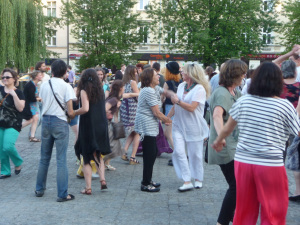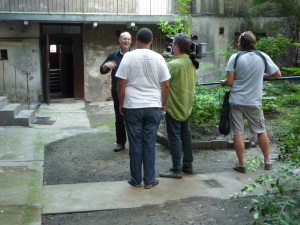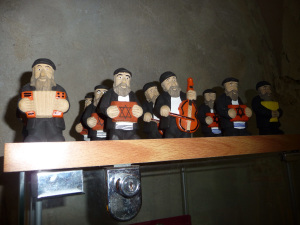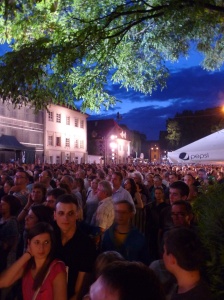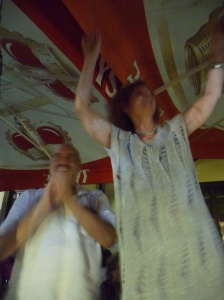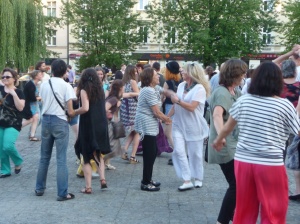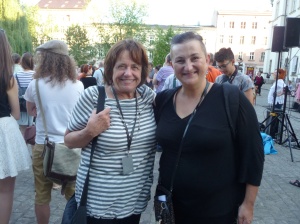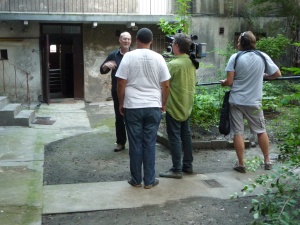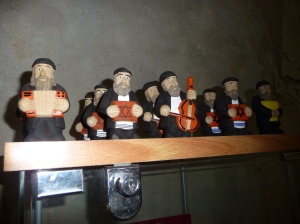Sometime during the early 20th C. the Gryn family, Szlama Daniel, his wife Feigel and ten children moved to Czestochowa, Poland. Their first child, Abraham, Ruth’s grandfather was born in Truskolasy a small village. Later children were born in Przystajn an even smaller shtetl. Burials seem to have been In Kzrepice.
Four days ago we traced this route under the guidance of Jakub Czuprynski, tour guide, historian, genealogist, soccer player, and a mere 34 years old. Not Jewish, Jakub represents an interesting Polish or more correct Krakovian phenomenon of intellectual non-Jews becoming heavily involved in the restoration of the memory of Polish Jews. Extremely knowledgeable, Jakub seemed to know every Jewish site in every shtetl we passed. Was there a synagogue there? A cemetery? Was it destroyed? He just knew.
We started out in Czestochowa, then made a big circle through Krzepice, Przystajn, and Truskolasy and back to Czestochowa. In Czestochowa we met Malgosia Malecka (Melgorzata or Margaret) who had spent hours locating the grave stone of Ruth’s Great Grandfather in the Czestochowa Jewish Cemetery. The cemetery is a jungle, heavily overgrown with no clear paths. It has not been mapped and it is huge. But she found it and led us to the site where we said Kaddish.
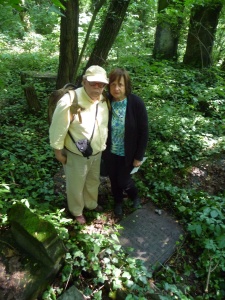
From there, we went to Targowa 14, the site of David and Rochma Hoffer’s (my grandparents) home where we walked around a large courtyard and saw where their mezuzah was placed. Many mezuzot had been removed after the War but the Hoffer’s was still there!
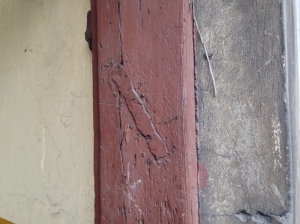
Mezuza at Targowa 14
We met Krzystof Straus there and he came prepared for our reunion from last year with 8×10 photographs of our family together with him at the Hasaq Memorial site. As Witek, his son who was with us last year suspected, the site is being prepared for new construction, making our Ner Tamid project integrating Hasaq barbed wire all the more poignant.
We saw how close their home was to the Nowy Rynek, the new market square, where Jewish people were rounded up for deportation. On one of those corners, my Dad’s family ran a grocery business.
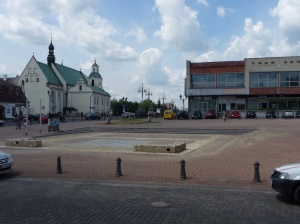
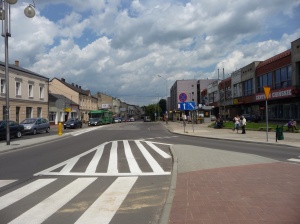
In Krzepice, we went to a cemetery where surely some of my Green family lay buried. We said Kaddish. Jakub, our guide, will send us a list of gravestones later.
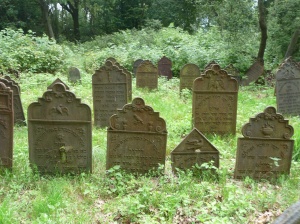
In general, what we saw were towns with no Jewish life where there once was much. But just as we marvel at the survivors and their resilience, we witnessed with respect the strides that the Polish people are making toward a better life since 1989 and the end of Communism. The villages and towns were quiet, clean, and showing the care of their inhabitants.
After a good humored laugh at the painting of strawberries that my Eemah had hung on her wall (I projected that this painting had something to to with the derivation of Truskolasy, a forest of strawberries). It was the only kitschy art my Mom was guilty of and after a photo of Walter and me there, we started back to Krakow.
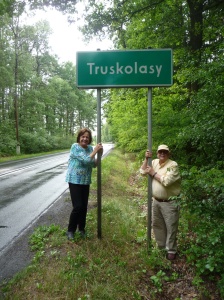
While travel in Poland will always carry with it a turn to the past, it is the present and future where hope lives. There are many Shabbos Goys who care that the Jewish void left after the Holocaust, the murders in Krakow in 1945 after the war, the pogrom in Kielce in 1946, and the expulsion of 30,000 Jewish people who had remained in Poland commiting themselves to the rebuilding of Poland in 1968 accusing Jewish people of being disloyal, be filled. Some scholars say the Communist party used Israel, Zionism and antisemitism as a tool to rid the country of opposition to Communism. There is always a reason.
However, the biggest surprise and delight is the “surprise” third generation, the Gimel generation. These are the young people who feel for reasons of felt or acknowledged roots, or for reasons of meeting a Jewish survivor they care about, or for love and interest in Jewish customs and traditions…. Jewish life, a desire to nurture a revival of Jewish life in Poland. The JCC here which was established in 2008 has 50 volunteers, mostly not Jewish. They affectionately call themselves Meshugoyim. Along with a most vibrant JCC here, six major Universities have Jewish Studies Programs with history, religion, Hebrew and Yiddish class offerings.
The rest of Europe and the U.S. could learn from the loving acceptance, low barrier to the “pintele Yid” many are getting in touch with in themselves that the Krakow JCC nurtures.
This brings us to this morning when we went to a Jewish Arts session. Two young artists, Helena Czernek and Aleksander Prugar, the presenters, led a group of mostly American Carthage College students, Walter and me, some Polish young people and a smattering of our peers in making a Shabbat table setting. Without influencing our ideas by showing their art, they showed the most traditional examples of candle sticks, challah platter, wine goblet, challah cover and table cloth. Divided into groups of five or six, each group made a setting using cloth, wood, glue, wire, paper, cloth crayons, scissors, wire cutters etc. The results were inspiring. Everyone was so engaged. In short, we had great fun.
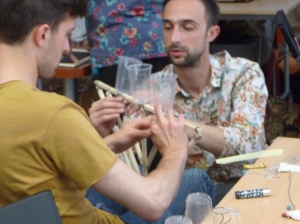
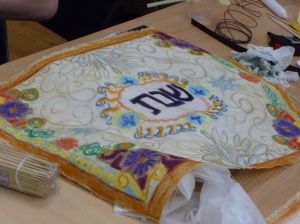
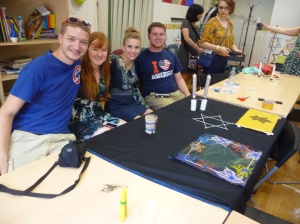
Our Midwest U.S.A. Group
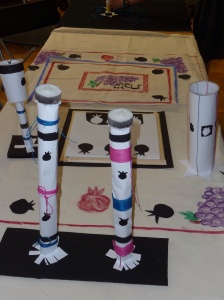
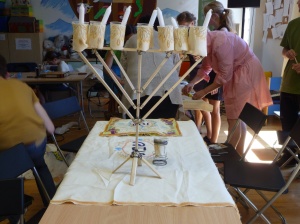
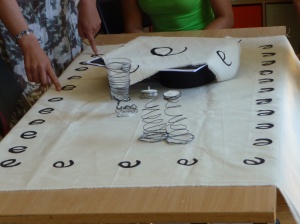
When we spoke to Helena and Aleksander, we learned of their work with Mezuzot.
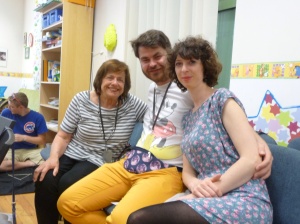
Another beshert coincidence, as we are so moved by the imprint of a mezuzah left on my Abba’s family home. They will be exhibiting their work in San Francisco and we must surely turn Corie and Ari and Ayelet and families and Sonia and Steve and ………. on to these artists. To be continued, we just need a date.
As you can see, it is the present and the future that now captures our hearts and minds. In tension with the past…yes. That too.
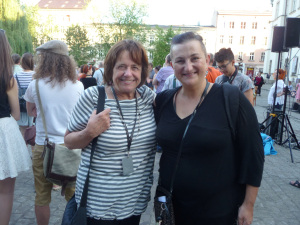 Ruth with Gabriela- the film maker
Ruth with Gabriela- the film maker 